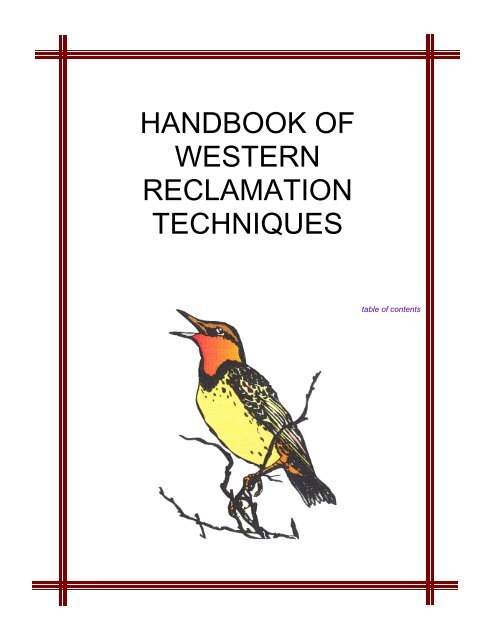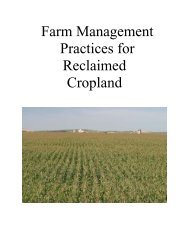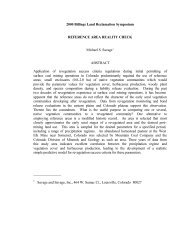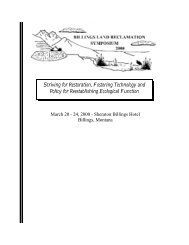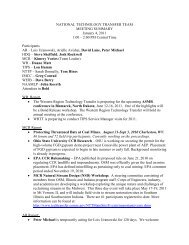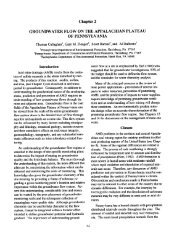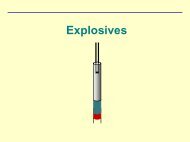handbook of western reclamation techniques - National Technology ...
handbook of western reclamation techniques - National Technology ...
handbook of western reclamation techniques - National Technology ...
You also want an ePaper? Increase the reach of your titles
YUMPU automatically turns print PDFs into web optimized ePapers that Google loves.
HANDBOOK OF<br />
WESTERN<br />
RECLAMATION<br />
TECHNIQUES<br />
table <strong>of</strong> contents
HANDBOOK OF<br />
WESTERN<br />
RECLAMATION TECHNIQUES<br />
by:<br />
Frank K. Ferris<br />
Larry H. Kleinman<br />
D.G. Steward<br />
Robert R. Stowe<br />
Laurel E. Vicklund<br />
John D. Berry<br />
Robert Cowan<br />
Claire Gabriel Dunne<br />
Richard Dunne<br />
Doyl M. Fritz<br />
Roy L. Garrison<br />
Robert K. Green<br />
Marlys M. Hansen<br />
C. Marty Jones<br />
Greg E. Jones<br />
Christopher D. Lidstone<br />
Marilee G. O'Rourke<br />
Bonnie C. Postovit<br />
Howard R. Postovit<br />
R.S. Shinn<br />
Patrick T. Tyrrell<br />
Richard C. Warner<br />
Kenneth L. Wrede
Permission is granted for the public to duplicate any part <strong>of</strong> this work, but permission should be<br />
requested from the authors to publish or incorporate any <strong>of</strong> this material into another document.<br />
Inquiries about this book can be presented to Frank K. Ferris, and questions or comments can be<br />
directed to the individual authors at the addresses presented in the List <strong>of</strong> Contributing Authors.<br />
These varied <strong>techniques</strong> have worked or are working for the technique author(s). However, the<br />
author(s) or editor(s) cannot warrant a technique. Sites, contractors, materials, specifications, and<br />
expectations differ.<br />
For additional copies, please contact:<br />
Publish Date: 12/31/96<br />
The Office <strong>of</strong> <strong>Technology</strong> Transfer<br />
Western Regional Coordinating Center<br />
Office <strong>of</strong> Surface Mining Reclamation and Enforcement<br />
1999 Broadway, Suite 3320<br />
Denver, CO 80202-5733<br />
Voice: (303) 844-1448<br />
Fax: (303) 844-1522<br />
E-mail: jgaletov@osmre.gov
ACKNOWLEDGEMENTS<br />
This work was supported in part by the Abandoned Coal Mine Lands (ACML) Research<br />
Program at the University <strong>of</strong> Wyoming. This support was administered by the Wyoming<br />
Department <strong>of</strong> Environmental Quality, Land Quality Division from funds returned to<br />
Wyoming from the Office <strong>of</strong> Surface Mining <strong>of</strong> the U.S. Department <strong>of</strong> Interior.<br />
University <strong>of</strong> Wyoming sponsors and coordinators:<br />
William Gern<br />
Angela Powell<br />
Roger Wilmot<br />
Office <strong>of</strong> Surface Mining sponsors and coordinators:<br />
Linda Wagner<br />
Joe Galetovic<br />
Additional support has been provided by:<br />
The Carter Mining Company<br />
Centralia Mining Company<br />
Cyprus-AMAX/Amax Coal West, Inc.<br />
Horizons, Inc.<br />
Kennecott Energy / Cordero Mining Company<br />
Kerr McGee Coal Corporation, Jacobs Ranch Mine<br />
Kiewit Mining Group<br />
Lidstone & Anderson, Inc.<br />
Powder River Coal Company<br />
Powder River Eagle Studies, Inc.<br />
Thunder Basin Coal Company - ARCO<br />
States West Water Resources Corp.<br />
Western Water Consultants<br />
Wind River Seed<br />
Wyodak Resources Development Corp.<br />
We would also like to express our appreciation to Excelcad in Gillette, Wyoming for the donated<br />
portion <strong>of</strong> the drafting work.<br />
We are grateful to the Office <strong>of</strong> <strong>Technology</strong> Transfer, Western Regional Coordinating Center,<br />
Office <strong>of</strong> Surface Mining for assistance with the technology transfer <strong>of</strong> this <strong>handbook</strong>.<br />
Handbook <strong>of</strong> Western Reclamation Techniques Page i
Management Committee:<br />
Managing Editor:<br />
Associate Editors:<br />
Section Editors:<br />
Frank K. Ferris<br />
Larry H. Kleinman<br />
D. G. Steward<br />
Robert R. Stowe<br />
Laurel E. Vicklund<br />
Marlys M. Hansen<br />
Wendy S. Hutchinson<br />
Roy S. Liedtke<br />
Frank K. Ferris<br />
Larry H. Kleinman<br />
Bonnie C. Postovit<br />
D. G. Steward<br />
Robert R. Stowe<br />
Laurel E. Vicklund<br />
EDITORS<br />
Handbook <strong>of</strong> Western Reclamation Techniques Page ii
TABLE OF CONTENTS<br />
Introduction ............................................................... 1<br />
References ............................................................... 3<br />
List <strong>of</strong> Contributing Authors ................................................... 6<br />
Section I: TOPSOIL<br />
A. Introduction ........................................................ I-1<br />
B. Salvage ........................................................... I-3<br />
1. Topsoil Identification and Salvage Control ............................. I-3<br />
2. Topsoil Stripping ................................................ I-11<br />
3. Topsoil Stockpiling .............................................. I-15<br />
4. Topsoil Stripping Equipment ....................................... I-17<br />
C. Replacement ...................................................... I-19<br />
1. Topsoil Replacement Depths ...................................... I-19<br />
2. Topsoil Replacement ............................................. I-23<br />
3. Elevation Control ............................................... I-27<br />
4. Preserving Seedbed Viability Through Direct Haul<br />
<strong>of</strong> Frozen Topsoil ............................................... I-31<br />
D. References ....................................................... I-33<br />
Section II: HYDROLOGY<br />
A. Introduction ........................................................II-1<br />
B. Control Structures ...................................................II-3<br />
1. Sediment Control Basin Design and Construction ........................II-3<br />
2. Diversion Design and Construction ..................................II-13<br />
3. Drop Structures .................................................II-21<br />
4. Backfill Impoundments ...........................................II-33<br />
C. Alternative Sediment Control ..........................................II-45<br />
1. Straw or Hay Bale Check Dams ....................................II-45<br />
2. Rock Check Dams ..............................................II-49<br />
3. Sediment Fence ................................................II-53<br />
4. Gabion Baskets .................................................II-59<br />
5. Vegetative Filters ...............................................II-65<br />
D. Reconstuction <strong>of</strong> Hydrologic Features ...................................II-67<br />
1. Small Drainage Waterway Construction ..............................II-67<br />
2. Stream Channel Construction ......................................II-75<br />
3. Wetlands Reconstruction .........................................II-83<br />
Handbook <strong>of</strong> Western Reclamation Techniques Page iii
4. Special Considerations in Planning and Constructing<br />
Permanent Postmining Impoundments ...............................II-93<br />
E. Hydrologic Control Structure Tolerances ................................II-103<br />
F. Surface Water Monitoring Using a Weir .................................II-113<br />
G. References ......................................................II-117<br />
H. Citations .........................................................II-120<br />
Section III: TOPOGRAPHY<br />
A. Introduction ....................................................... III-1<br />
B. Hills/Slopes ....................................................... III-3<br />
1. Hillslope Shaping and Morphology .................................. III-3<br />
2. Backfill Grading Observations .................................... III-13<br />
3. Evaluation and Comparison<br />
<strong>of</strong> Topographic Descriptive Methods ............................... III-19<br />
C. References ...................................................... III-25<br />
Section IV: WILDLIFE MITIGATION AND PROTECTION<br />
A. Introduction ....................................................... IV-1<br />
B. Practices During Mining .............................................. IV-3<br />
1. Fencing Practices and Wildlife ..................................... IV-3<br />
2. Reducing Powerline Hazards ...................................... IV-7<br />
3. Traffic and Roadways ........................................... IV-13<br />
4. Providing Interim Wildlife Habitat ................................... IV-15<br />
5. Raptor Nest Relocation .......................................... IV-25<br />
6. Animal Control ................................................ IV-27<br />
C. References ...................................................... IV-37<br />
Section V: VEGETATION<br />
A. Introduction ....................................................... V-1<br />
B. Establishing and Implementing a Revegetation Program ..................... V-3<br />
1. Preparing a Revegetation Package ................................. V-3<br />
2. Cultivation Practices ............................................ V-11<br />
3. Drill Seeding Practices .......................................... V-17<br />
4. Hydroseeding Practices ......................................... V-23<br />
5. Mulching Practices ............................................. V-27<br />
6. Seed Handling ................................................ V-33<br />
7. Planting Methods for Permanent Reclamation ........................ V-37<br />
8. Broadcast Seeding ............................................. V-39<br />
9. Transplanting Live Plants and Planting Plant Parts .................... V-41<br />
Handbook <strong>of</strong> Western Reclamation Techniques Page iv
10. Reforestation .................................................. V-45<br />
11. Seeding Shrub Seed ............................................ V-49<br />
C. Seed Ordering Methods ............................................. V-55<br />
1. Ordering Seed ................................................ V-55<br />
2. Preparing a Seed Purchase Request ............................... V-57<br />
3. Warm Season Grasses -- The Importance or Origin <strong>of</strong><br />
Named Varieties and Native Harvests .............................. V-61<br />
4. Certified Blue-tag Versus Non-certified (Common) Seed ............... V-65<br />
5. Source-identified Yellow-tagged Seed .............................. V-67<br />
6. Understanding Seed Tests ....................................... V-69<br />
7. Determining Pure Live Seed ...................................... V-75<br />
8. Selecting Good Shrub Seed ...................................... V-77<br />
D. Surface Stabilization ............................................... V-83<br />
1. Vegetative Surface Stabilization ................................... V-83<br />
2. Non-vegetative Surface Stabilization ................................ V-87<br />
E. Husbandry ....................................................... V-89<br />
1. Mowing for Weed Control ........................................ V-89<br />
2. Burning to Enhance Vegetation ................................... V-91<br />
3. Husbandry Grazing ............................................. V-93<br />
F. Monitoring ....................................................... V-97<br />
1. Vegetation Sampling ........................................... V-97<br />
2. Recordkeeping Practices ........................................V-107<br />
3. Electronic Document Management in Mining .........................V-113<br />
G. References ......................................................V-119<br />
Section VI: POSTMINING LAND USE<br />
A. Introduction ....................................................... VI-1<br />
B. Grazing .......................................................... VI-3<br />
1. Early Implementation <strong>of</strong> Postmining Land Use - Grazing as Husbandry ...... VI-3<br />
2. Establishing and Controlling a Grazing Program on the Mine Site;<br />
Initial Planning .................................................. VI-7<br />
3. Establishing and Controlling a Grazing Program on the Mine Site;<br />
Writing the Grazing Contract ...................................... VI-15<br />
4. Establishing and Controlling a Grazing Program on the Mine Site;<br />
Implementation ................................................ VI-19<br />
5. Creating Livestock Pastures ...................................... VI-23<br />
6. Water Sources for Livestock ...................................... VI-33<br />
7. Moving Livestock ............................................... VI-45<br />
8. Vegetation Quality for Grazing .................................... VI-53<br />
Handbook <strong>of</strong> Western Reclamation Techniques Page v
9. Timing <strong>of</strong> Grazing .............................................. VI-57<br />
10. Grazing, Wildlife, and Wildlife Habitat .............................. VI-65<br />
C. Wildlife .......................................................... VI-69<br />
1. Forage Enhancement for Wildlife .................................. VI-69<br />
2. Water Resources .............................................. VI-71<br />
3. Rockpile Design and Construction .................................. VI-75<br />
D. References ...................................................... VI-83<br />
E. Citations ......................................................... VI-84<br />
Section VII: DRILLING PROGRAM<br />
A. Introduction ...................................................... VII-1<br />
B. Pre-drilling Requirements ............................................ VII-3<br />
1. Identifying Drilling Needs ......................................... VII-3<br />
2. Identifying Logging and Sampling Requirements ...................... VII-7<br />
3. Identifying Number, Size, Location, and Depth <strong>of</strong> Drill Holes ............ VII-11<br />
4. Pre-field Permitting and Reclamation Planning ...................... VII-15<br />
5. Contracting the Drilling Program ................................. VII-21<br />
6. Sample Storage .............................................. VII-27<br />
C. Field Work ...................................................... VII-29<br />
1. Field Activities ............................................... VII-29<br />
2. Sample Collection ............................................. VII-33<br />
3. Well Drilling .................................................. VII-37<br />
4. Logging ..................................................... VII-39<br />
D. Post-drilling Requirements .......................................... VII-43<br />
1. Drill Hole Reclamation ......................................... VII-43<br />
2. Post-drilling Responsibilities ..................................... VII-45<br />
3. Reporting, Inspection, and Recordkeeping Requirements .............. VII-49<br />
E. References ..................................................... VII-51<br />
Handbook <strong>of</strong> Western Reclamation Techniques Page vi
INTRODUCTION<br />
The Handbook <strong>of</strong> Western Reclamation Techniques is the culmination <strong>of</strong> cooperative effort <strong>of</strong> the<br />
mining industry, industry pr<strong>of</strong>essionals, the academic community, and regulatory agencies. It is<br />
designed to document field proven <strong>reclamation</strong> methods. The field <strong>techniques</strong> described herein<br />
demonstrate the variety <strong>of</strong> different methodologies utilized to accomplish similar tasks. Many <strong>of</strong><br />
these <strong>techniques</strong> were developed from scientific studies and have evolved over time. Although<br />
mining has occurred for over a century, concerted <strong>reclamation</strong> efforts for coal mines began in<br />
response to laws such as the Wyoming Environmental Quality Act (WEQA) <strong>of</strong> 1973, and the<br />
Surface Mine Control and Reclamation Act (SMCRA) <strong>of</strong> 1977. Reclamation that has been<br />
successful allows surface coal mine operators to redeem bonds that were posted prior to the initial<br />
disturbance. These <strong>reclamation</strong> bonds are required by SMCRA and WEQA.<br />
The roots <strong>of</strong> <strong>reclamation</strong> science lie in the conservation practices developed during the dustbowl<br />
and depression years <strong>of</strong> the 1930's. Many <strong>of</strong> the practices developed, and much <strong>of</strong> the work done<br />
during that time, was funded by Federal and State governments. For this reason, many <strong>of</strong> the<br />
names associated with early <strong>reclamation</strong> <strong>of</strong> mined lands -- McKell; Bjugstad; Power, Sandoval, and<br />
Ries; Aldon; Plummer; Richardson and Farmer; and Hodder -- are also names from the Soil<br />
Conservation Service, the Agricultural Research Stations, and land grant universities. Early mine<br />
<strong>reclamation</strong> was so associated with agriculture that <strong>reclamation</strong> and revegetation were considered<br />
virtually synonymous.<br />
While some agricultural emphasis continues today, the technology has expanded greatly to<br />
embrace hydrology, wildlife, and compliance. Reclamation science has responded to legal<br />
requirements, reconstruction <strong>of</strong> endangered habitats, revitalization <strong>of</strong> damaged environmental<br />
systems, and establishment <strong>of</strong> wetlands. Reclamation methods are used to minimize the impact<br />
<strong>of</strong> human development in housing subdivisions, on ski slopes, and in highway reconstruction.<br />
Early <strong>reclamation</strong> investigations in the arid and semi-arid Western United States were based on<br />
research trials for replacing soils and re-establishing vegetation. Cook et al. (1974), Power et al.<br />
(1976), the SEAM program (1979), and DePuit and Coenenberg (1981) are good examples <strong>of</strong><br />
earlier efforts that continue today in work by Schumann et al. (1993). Plant materials centers and<br />
agricultural research stations continue to provide tools for <strong>reclamation</strong> efforts (e.g. Ries et al. 1976,<br />
Aldon 1981, Bjugstad 1984, and Majerus et al. 1985).<br />
Researchers such as Shroeder (1985), Toy (1983), and Toy and Parsons (1987) produced<br />
research on geomorphic processes such as erosion, infiltration, and sediment yield, while<br />
Beauchamp (1973), Dollhopf (1978), Berg (1983), and Halvorson and Doll (1985) investigated spoil<br />
and soil in the reclaimed environment. A great deal <strong>of</strong> applied research has been conducted by<br />
Handbook <strong>of</strong> Western Reclamation Techniques Page 1
mining companies interested in seeking new solutions to <strong>reclamation</strong> problems. Much <strong>of</strong> this<br />
work is reported in the annual reports required by State agencies for each active mine.<br />
Postovit (1981), Hingtgen and Clark (1984a and 1984b), Yoakum (1984), Clark and Medcraft<br />
(1986), and Medcraft and Clark (1986) studied the effects <strong>of</strong> mining on wildlife populations.<br />
Olendorf et al. (1981) and Nelson et al. (1978) described <strong>techniques</strong> for wildlife habitat restoration.<br />
Methods and classification for reconstruction <strong>of</strong> stream channels are being developed by Wesche<br />
et al. (1993) and Rathburn et al. (1993).<br />
There are many works which suggest technologies <strong>of</strong> various kinds, report on field trials, and<br />
recommend plant species for use in <strong>reclamation</strong>. However, twenty years after the earliest efforts,<br />
a considerable body <strong>of</strong> practical knowledge has been developed among the specialists charged<br />
with the duty <strong>of</strong> complying with State and Federal statutes and regulations governing <strong>reclamation</strong><br />
<strong>of</strong> mined lands. For the most part this knowledge has never been formalized and made generally<br />
accessible until presentation in this <strong>handbook</strong>.<br />
The Handbook <strong>of</strong> Western Reclamation Techniques was designed in a binder format with the<br />
capability <strong>of</strong> adding or replacing sections as new <strong>techniques</strong> are developed. Plans and diagrams<br />
can be easily removed to make working copies <strong>of</strong> a subsection. This <strong>handbook</strong> has been written<br />
and assembled by the volunteer labor <strong>of</strong> interested authors and a smaller volunteer editorial<br />
committee. Many <strong>of</strong> these people gained their experience in the surface coal mines <strong>of</strong> Wyoming.<br />
ACML funds were utilized for support services such as administration, assembly, drafting, literature<br />
review, and word processing. We are grateful for the printing <strong>of</strong> this <strong>handbook</strong> by the Office <strong>of</strong><br />
Surface Mining.<br />
It is the intent <strong>of</strong> the authors to present, in an accessible format, economical and successful<br />
<strong>reclamation</strong> <strong>techniques</strong> that have survived the test <strong>of</strong> practical application. Many <strong>of</strong> the <strong>techniques</strong><br />
are a cumulation <strong>of</strong> scientific studies and practical experience. Since some <strong>of</strong> these methodologies<br />
may not have been previously documented, the authors feel compiling this <strong>handbook</strong> is an<br />
important contribution to <strong>reclamation</strong>. It is the hope <strong>of</strong> the authors that the distribution <strong>of</strong> these<br />
<strong>techniques</strong> will positively affect not only the <strong>reclamation</strong> <strong>of</strong> surface coal-mined lands, but will also<br />
be <strong>of</strong> potential service in many <strong>reclamation</strong> fields.<br />
Handbook <strong>of</strong> Western Reclamation Techniques Page 2
REFERENCES<br />
Aldon, E.F. 1981. Long-term Plant Survival and Density Data from Reclaimed South<strong>western</strong><br />
Coal Mine Spoils. Great Basin Nat. 41(3): 271-273.<br />
Beauchamp, H.L. 1973. The Use <strong>of</strong> Topsoil for Strip Mine Revegetation. MS Thesis. University <strong>of</strong><br />
Wyoming. Laramie. 22 p.<br />
Berg. M.G., editor. 1983. Soil and Overburden Requirements for Successful Revegetation.<br />
Proceedings <strong>of</strong> the Conference held 22 February 1983 in Denver, Colorado. Available from<br />
the Office <strong>of</strong> Surface Mining, Denver, Colorado. 186 p.<br />
Bjugstad, A.J. 1984. Shrub and Tree Establishment on Coal Spoils in Northern High Plains.<br />
pp 223-236. In: Proceedings <strong>of</strong> the Third Biennial Symposium on Surface Coal Mine<br />
Reclamation on the Great Plains. Available from the Reclamation Research Unit. Montana<br />
State University. Bozeman. 371 p.<br />
Clark, W.R. and J.R. Medcraft. 1986. Wildlife Use <strong>of</strong> Shrubs on Reclaimed Surface-mined Land<br />
in Northeastern Wyoming. Journal <strong>of</strong> Wildlife Management 50(4): 714-718.<br />
Cook, C.W., R.M. Hyde, and P.L. Sims. 1974. Revegetation Guidelines for Surface Mined Areas.<br />
Colorado State University. Range Science Department Science Series No. 16. Fort Collins.<br />
73 p.<br />
DePuit, E.J. and J.G. Coenenberg. 1981. Establishment <strong>of</strong> Diverse Native Plant Communities<br />
on Coal Surface-mined Lands in Montana as Influenced by Seeding Method, Mixture, and<br />
Rate. Montana State University. Montana Agricultural Experimental Station Research<br />
Report 163. Bozeman. 64 p.<br />
Dollhopf, D.J., J.D. Goering, C.J. Levine, B.J. Bauman, D.W. Hedberg, and R.L. Hodder. 1978.<br />
Selective Placement <strong>of</strong> Coal Stripmine Overburden in Montana: Spoil Mixing Phenomena.<br />
Montana Agricultural Experiment Station Reclamation Research Program. Interim Report<br />
No. 135, June 1978. Montana State University, Bozeman, Montana.<br />
Halvorson, G.A. and E.C. Doll. 1985. Topsoil and Subsoil Replacement on Strip Mined Land in<br />
North Dakota. pp 232-241. In: Proceedings <strong>of</strong> the Second Annual Meeting <strong>of</strong> the American<br />
Society for Surface Mining and Reclamation. Copies available from Bill Plass, 21<br />
Grandview Drive, Princeton, West Virginia, 24740. 411 p.<br />
Hingtgen, T.M. and W.R. Clark. 1984a. Impacts <strong>of</strong> Small Mammals on the Vegetation <strong>of</strong> Reclaimed<br />
Land in the Northern Great Plains. Journal <strong>of</strong> Range Management 37(5): 438-441.<br />
Hingtgen, T.M. and W.R. Clark. 1984b. Small Mammal Recolonization <strong>of</strong> Reclaimed Coal Surfacemined<br />
Land in Wyoming. Journal <strong>of</strong> Wildlife Management 48(4): 1255-1261.<br />
Handbook <strong>of</strong> Western Reclamation Techniques Page 3
Majerus, M.E., J.G. Scheetz, and L.K. Holzworth. 1985. Selecting Plants for Mine Reclamation in<br />
Western Wyoming. pp 139-143. In: Proceedings <strong>of</strong> the Second Annual Meeting <strong>of</strong> the<br />
American Society for Surface Mining and Reclamation. Copies available from Bill Plass,<br />
21 Grandview Drive, Princeton, West Virginia, 24740. 411 p.<br />
Medcraft, J.R. and W.R. Clark. 1986. Big Game Habitat Use and Diets on a Surface Mine in<br />
Northeastern Wyoming. Journal <strong>of</strong> Wildlife Management 50(2): 135-142.<br />
Nelson, R.W., G.C. Horak, and J.E. Olson. 1978. Western Reservoir and Stream Habitat<br />
Improvements Handbook: Guide to the Performance <strong>of</strong> Fish and Wildlife Habitat and<br />
Population Improvement Measures Accompanying Water Resource Development.<br />
Prepared for the Western Energy and Land Use Team. Office <strong>of</strong> Biological Service. Fish<br />
and Wildlife Service. Fort Collins, Colorado. 250 p.<br />
Olendorf, R.R., A.D. Miller, and R.N. Lehman. 1981. Suggested Practices for Raptor Protection on<br />
Power Lines: the State <strong>of</strong> the Art in 1981. Raptor Research Report No. 4: Raptor Research<br />
Foundation, Inc. University <strong>of</strong> Minnesota. St. Paul. 111 p.<br />
Postovit, B.C. 1981. Suggestions for Sage Grouse Habitat Reclamation on Surface Mines in<br />
Northeastern Wyoming. MS Thesis. University <strong>of</strong> Wyoming. Laramie. 50 p.<br />
Power, J.F., R.E. Ries, and F.M. Sandoval. 1976. Use <strong>of</strong> Soil Materials on Spoils -- Effects <strong>of</strong><br />
Thickness and Quality. Farm Research 34(1): 23-24.<br />
Rathburn, S.L., P.A. Rechard, T. Hanlin, and D.R. Jensen. 1993. Long-term Stability <strong>of</strong> Designed Ephemeral Channels at Reclaimed Coal Mines, Wyoming. Final executive summary for<br />
Abandoned Coal Mine Lands Research Program. Western Water Consultants. Laramie, Wyoming.<br />
Ries, R.E., J.F. Power, and F.M. Sandoval. 1976. Potential Use <strong>of</strong> Supplemental Irrigation for<br />
Establishment <strong>of</strong> Vegetation on Surface-mined Lands. North Dakota Agricultural<br />
Experimental Station, Farm Research 35(1): 21-22.<br />
Schumann, G.E., D.T. Booth, and J.R. Cockrell. 1993. Strategies for Establishment <strong>of</strong> Big<br />
Sagebrush (Artemisia tridentata ssp. wyomingensis). Semi-annual report for the<br />
Abandoned Coal Mine Lands Research Program. University <strong>of</strong> Wyoming. Laramie.<br />
SEAM. 1979. User Guide to Vegetation. In: Mining and Reclamation in the West. USDA Forest<br />
Service General Technical Report INT-64. Intermountain Forest and Range Experiment<br />
Station. Ogden, Utah. 85 p.<br />
Shroeder, S.A. 1985. Effect <strong>of</strong> Crusting on Run<strong>of</strong>f and Erosion from Reshaped Spoil. In:<br />
Proceedings <strong>of</strong> the Second Annual Meeting <strong>of</strong> the American Society for Surface Mining and<br />
Reclamation. Copies available from Bill Plass, 21 Grandview Drive, Princeton, West<br />
Virginia. 24740. 411 p.<br />
Handbook <strong>of</strong> Western Reclamation Techniques Page 4
Toy, T.J. 1983. Evaluating Run<strong>of</strong>f and Erosion from Reclaimed Hillslopes: Two Case Studies. pp<br />
43-46. In: Proceedings <strong>of</strong> the Conference on Soils and Overburden in Reclamation <strong>of</strong><br />
Arid/Semi-arid Mined Lands. Available from the University <strong>of</strong> Wyoming. Laramie. 75 p.<br />
Toy, T.J. and S. Parsons. 1987. Geomorphic Stability in Reclaimed Landscapes. In: Proceedings<br />
<strong>of</strong> the Fourth Biennial Symposium on Surface Mining and Reclamation on the Great Plains.<br />
Available from the Reclamation Research Unit as Report No. 8704. Montana State<br />
University. Bozeman.<br />
Wesche, T.A., H.W. Lowham, R.L. Daddow, M.E. Smith. 1993. Methodology for the Geomorphic<br />
Classification and Design <strong>of</strong> Drainage Basins and Stream Channels in the Powder River<br />
Coal Field <strong>of</strong> Wyoming. Semi-annual report for the Abandoned Coal Mine Lands Research<br />
Program. University <strong>of</strong> Wyoming. Laramie.<br />
Yoakum, J. 1984. Pronghorn Habitat Requirements and Reclamation. In: Proceedings <strong>of</strong> the Third<br />
Biennial Symposium on Surface Coal Mining and Reclamation in the Great Plains. pp 148-<br />
155. Available from the Reclamation Research Unit. Montana State University. Bozeman.<br />
371 p.<br />
Handbook <strong>of</strong> Western Reclamation Techniques Page 5
LIST OF CONTRIBUTING AUTHORS<br />
Name Company Phone<br />
John D. Berry Kiewit Mining Group (307)672-3401<br />
P.O. Box 3049<br />
Sheridan, WY 82801<br />
Robert Cowan C.E. & M.T. (307)686-6409<br />
P.O. Box 4098<br />
Gillette, WY 82717<br />
Claire Gabriel Dunne Wind River Seed (307)568-3361<br />
Richard Dunne 3075 Lane 51-1/2<br />
Manderson, WY 82432<br />
Frank K. Ferris Amax Coal West, Inc. (307)687-3307<br />
Eagle Butte Mine<br />
P.O. Box 3040<br />
Gillette, WY 82717-3040<br />
Doyl M. Fritz Western Water Consultants (307)672-0761<br />
1949 Sugarland Drive, Suite 134<br />
Sheridan, WY 82801<br />
Roy L. Garrison Centralia Mining Company (360)736-2831<br />
1015 Big Hanaford Road extension 298<br />
Centralia, WA 98531-9100<br />
Robert K. Green Kennecott Energy Company (307)687-6061<br />
Caller Box 3009<br />
Gillette, WY 82717-3009<br />
Marlys M. Hansen Powder River Eagle Studies (307)687-3204<br />
P.O. Box 2411<br />
Gillette, WY 82717-2411<br />
Wendy S. Hutchinson Thunder Basin Coal Company (307)939-1300<br />
Black Thunder Mine extension 113<br />
P.O. Box 406<br />
Wright, WY 82732<br />
C. Marty Jones Lidstone & Anderson, Inc. (970)226-0120<br />
736 Whalers Way, Suite F200<br />
Fort Collins, CO 80525<br />
Greg E. Jones Powder River Coal Company (307)464-4682<br />
Caller Box 3034<br />
Gillette, WY 82717-3034<br />
Handbook <strong>of</strong> Western Reclamation Techniques Page 6
Larry H. Kleinman Kiewit Mining Group (307)672-3401<br />
P.O. Box 3049<br />
Sheridan, WY 82801<br />
Christopher D. Lidstone Lidstone & Anderson, Inc. (970)226-0120<br />
736 Whalers Way, Suite F200<br />
Fort Collins, CO 80525<br />
Roy S. Liedtke Kerr McGee Coal Corporation (307)464-5526<br />
Jacobs Ranch Mine<br />
Caller Box 3013<br />
Gillette, WY 82717<br />
Marilee G. O'Rourke Powder River Coal Company<br />
Caller Box 3034<br />
Gillette, WY 82717<br />
Bonnie C. Postovit Powder River Eagle Studies (307)686-6178<br />
Howard R. Postovit P.O. Box 2411<br />
Gillette, WY 82717-2411<br />
R.S. Shinn P.O. Box 3028-5046 (307)686-7286<br />
Gillette, WY 82717-3028<br />
D.G. Steward Cyprus Climax Metals<br />
P.O. Box 22015<br />
Tempe, AZ 85285-2015<br />
Robert R. Stowe Amax Coal West, Inc. (307)687-3412<br />
Belle Ayr Mine<br />
P.O. Box 3039<br />
Gillette, WY 82717-3039<br />
Patrick T. Tyrrell States West Water Resources Corp. (307)634-7848<br />
Suite 204, Pioneer Center<br />
2424 Pioneer Ave.<br />
Cheyenne, WY 82001<br />
Laurel E. Vicklund Kennecott Energy (307)686-5505<br />
Cordero Mine<br />
P.O. Box 1449<br />
Gillette, WY 82717-1449<br />
Richard C. Warner University <strong>of</strong> Kentucky (606)257-3000<br />
Bio-Systems and Agricultural Engineering extension 217<br />
128 Agricultural Engineering Bldg.<br />
Lexington, Kentucky 40546-0276<br />
Kenneth L. Wrede Horizons, Inc. (605)343-0280<br />
3600 Jet Drive<br />
Rapid City, SD 5770<br />
Handbook <strong>of</strong> Western Reclamation Techniques Page 7


